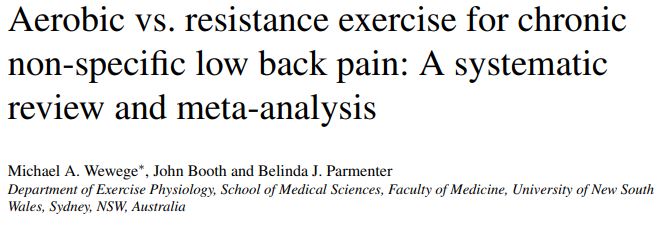Low back pain is the leading cause of disability worldwide. Exercise helps alleviate back pain, which modality, Progressive aerobic or progressive resistance training is superior?
Wewege et al.1 conducted a meta-analysis to compare the differences between progressive aerobic training (PAT) and progressive resistance training (PRT) on the treatment of chronic non-specific low back pain (CNSLBP). Six studies were included, including 333 participants. 94 of these participants received PRT, 93 PAT, and 146 received the control of usual care. 66% were female and they were aged 44 plus or minus 6 years; with duration of pain of 7 plus or minus 6 years.
All six studies were randomized control trials (RCTs). In all studies all exercise had to be conducted greater than or equal to 2 days/week and have training duration greater than or equal to 6 weeks, requiring at least one supervised exercise session a week. The resistance training studies analyzed employed multi-joint exercises, as opposed to exercises targeting the abdominals or erector spinae muscles.
PAT could be any activity intended to improve cardiovascular fitness such as elliptical, walking, jogging, or running. PRT was defined as resistance training via machine or free weights.
Outcome measurements were pain intensity, disability, and quality of life (including the Short Form Health Survey-Mental Component Score Sf-MCS). Analysis of PAT and PRT data shows a significant reduction in pain intensity in adults with CNSLBP. Neither modality of exercise, PAT or PRT proved superior. Of note, only high intensity PRT (60 – 70% 1RM performed 3 times per week for 4 months) demonstrated an improvement in the SF-MCS (a psychological well-being survey) compared to PAT. This further promotes the significant effect PRT can have on improving psychological wellbeing.
There is no consensus on what choice of exercise modality optimally treats CNSLBP. Why not both? Get creative, find what you like and choose the exercise that you can realistically adhere to for a long time and give it all you’ve got. Work hard, and do hard things to increase your comfort zone to improve tolerance for chronic pain. If you can’t cure your chronic pain, try to improve it; even if just slightly. This study found that moderate to high intensity exercise (PRT and/or PAT) 3 days/week offered the greatest benefits. This might not be your starting point, but it can be a target to aim up towards.
- Wewege MA, Booth J, Parmenter BJ. Aerobic vs. resistance exercise for chronic non-specific low back pain: A systematic review and meta-analysis. J Back Musculoskelet Rehabil. 2018;31(5):889-899. doi:10.3233/BMR-170920

